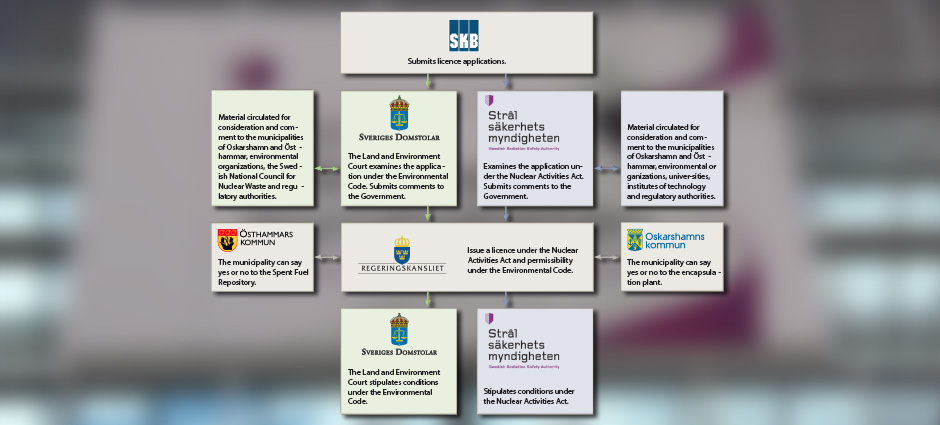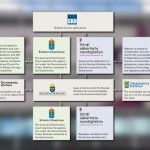The review process
The authorities review – the Government decides
SKB’s applications for licences to construct a spent fuel repository in Forsmark and an encapsulation plant in Oskarshamn have been reviewed by the Swedish Radiation Safety Authority and the Land and Environment Court and are now with the Government for decision.
The licensing process has taken several years and the final decision is made by the Government after the municipalities has answered yes or no. The Swedish Radiation Safety Authority (SSM) and the Land and Environment Court (MMD) have reviewed SKB’s applications. SSM’s licensing is carried out under the Nuclear Activities Act and MMD’s under the Environmental Code.
SKB’s applications were submitted to the regulatory authorities in March 2011. Shortly thereafter, the review was initiated. The documentation was reviewed by the regulatory authorities’ own experts and a large number of reviewing bodies. The concerned municipalities and county administrative boards, universities and higher education institutions, environmental organisations and others have had the opportunity to give their opinions.
Independent experts
Furthermore, the State requested that an independent international review would be made of the long-term safety after closure of the Spent Fuel Repository. The review was carried out by a group of experts appointed by the OECD’s Nuclear Energy Agency NEA. The group submitted its final report in June 2012 and it gave a favourable opinion on this part of the application.
Answers from two authorities
The main hearing on SKB’s application was held in MMD in the autumn of 2017 and, in January 2018, the court submitted its opinion to the Government. The court was positive in several important respects, for example, it says yes to the issues relating to the site Forsmark, the rock, the buffer, the environmental impact statement and the facilities in Oskarshamn, but it calls for more documentation on the copper canisters. SSM also provided its answer in January and the authority’s statement was a clear yes to SKB’s system for final disposal of spent nuclear fuel
Approved by the Government
In April 2019 SKB submitted the documentation required by MMD to the Government. The concerned municipalities, Östhammar and Oskarshamn, which have the right of a veto in the matter, have both said yes to the establishments. Östhammar Municipality regarding the Spent Fuel Repository and Oskarshamn Municipality regarding the encapsulation plant. So matter was then put on the Government’s table for decision. In January 2022, the Government approved SKB’s application.
Conditions with enforcement order
After the Government has made its decision, the case was referred back to the Land and Environment Court (MMD) and the Swedish Radiation Safety Authority (SSM) to set conditions under the Environmental Code and the Nuclear Activities Act. In October 2024, MMD issued an environmental ruling with specific conditions and an enforcement order, which meant that preparatory work could be started above ground.
In January 2025, SKB submitted an application along with a Preliminary Safety Analysis Report (PSAR). SSM is currently reviewing the report.
The preparatory work above ground began around the turn of the year 2024/2025 and is expected to continue for up to two years. Once SSM has completed its review and granted approval, construction of the underground facility will begin.
The municipalities will also decide whether to grant building permits under the Planning and Building Act.
Once permits have been granted, this does not mean that the process is finished. There are a large number of controls that have to be passed before nuclear technology plants can be built. For instance additional permits are required from the Swedish Radiation Safety Authority before building can start, trial operations can begin, for routine operation and finally for phasing facilities out and sealing them. At each of these stages the preliminary safety analysis contained in SKB’s applications have to be expanded and become increasingly detailed.
Last review: August 12, 2025
Last review: August 12, 2025

